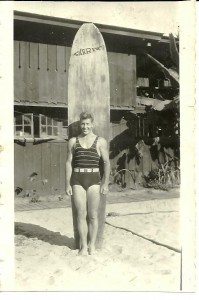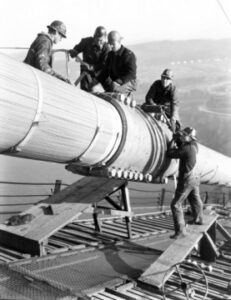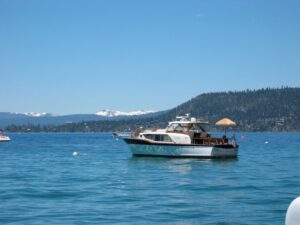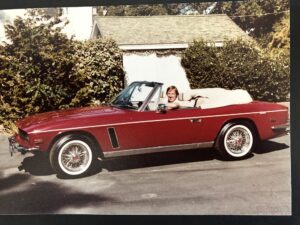Born: July 2, 1910; St. Helena, California
Death: October 5, 1991; Sonoma, California
Lawrence Howard Good (“Howard”) was born in 1910 in St. Helena, California. He was the son of Stanley Wells Good and Cornelia Wheeler Good, known to their grandchildren as “Tapah” and “Namah”. Stanley spent his career in trans-Pacific shipping when ships, along with railroads, were the primary mode of long-distance transportation. While general manager of the Pacific Mail Steamship Company in San Francisco, Stanley made voyages to Hawaii, then a territory of the US. He established a worthy reputation in the Islands and the Far East, and when the Dollar Steamship Company expanded its Pacific trade, Stanley was hired to lead the Honolulu office in that effort. He and his family moved to Honolulu in 1920. Howard, his older sister, Harriette and older brother, Stanley Jr. (”Stan”) were early students at Punahou School, and Howard graduated in 1928.
These were glory years to grow up in Hawaii. Howard, Stan, and their friends were surfers, enjoying the beach at Waikiki with the likes of Duke and Louis Kahanamoku. Duke became known as the father of Hawaii surfing; a monument in his memory can be found at the Diamond Head end of Waikiki Beach. Howard’s surfboard, the “Shark”, made from the wood of a koa tree, was about 16 feet long and weighed over 100 pounds. The board was without a skeg, which had yet to be invented.
Howard became an accomplished swimmer, winning the state backstroke championship in his junior and senior years at Punahou. He graduated in 1928 and spent the summer with his brother Stan on a Dollar steamer to the Orient as cabin boys. They stayed at the now famous Peninsula Hotel in Hong Kong for its grand opening that year.
Howard attended the University of Hawaii from late 1928 through 1931, majoring in civil engineering. These were the early days of the Great Depression when the national unemployment rate was approaching 20%. Engineering jobs were non-existent in Hawaii, so Howard returned to Dollar Steamship for the next four years.
In 1935, he took an engineering position with the American Bridge Company, which was constructing the San Francisco Bay Bridge. Across the Bay at the same time, the John A. Roebling’s Sons Company was building the Golden Gate Bridge and Howard soon joined the engineering team there. He worked on the main cable before the roadway was built, sometimes working over 700 feet above the water. The bridge would become the longest suspension bridge in the world. The Bay Bridge was completed in late 1936 and the Golden Gate in mid-1937.With the bridges completed, he joined Hawaiian Pineapple Company in San Francisco, furthering his export and import expertise. With the annexation of Hawaii to the United States in 1903, selling agricultural products to the mainland became much more profitable because – those products were notsubject to import tariffs. Howard helped build Hawaiian Pine’s sales to the Orient.
All the while, Howard’s grandfather, John Hoffman Wheeler, maintained Wheeler Farms in St. Helena as the family gathering place. While visiting one weekend in 1936, Howard met Jane Lines, who was a friend of his cousin, Patsy, at Mills College. They would be married in the fall of 1938.
During World War II, Howard worked at the naval shipyard in Sausalito. Before the war’s end, Howard and Jane had three children-Valerie, Tony, and David. Son Stuart was born in 1951. After the war, he met Walter Boysen, who was expanding his paint company in Emeryville. Walter envisioned exporting paint and other building supplies to the war-torn areas of the Pacific- primarily Hawaii, Guam, and the Philippine Islands. With his knowledge of the South Pacific and exporting, Howard was a natural and joined Boysen in 1946, where he remained as Export Manager until his retirement in 1970.
In 1953, the Goods purchased a lakeside property in Homewood, 6 miles south of Tahoe City. The property was known as “Snug Harbor” and over the ensuing years, Howard remodeled the main house, built a separate garage complex complete with a dormitory and workshop, installed a paddle tennis court and constructed a pier and boathouse. Howard acquired a 51’ Chris Craft yacht from his brother in the mid 60’s, the HMS Pinafore, which the family enjoyed for years. Valerie, Tony, David, and Stuart spent many idyllic summers at Tahoe. Valerie and David were also fortunate to attend many events at the 1960 Winter Olympic Games in Squaw Valley, including the ice hockey gold medal game won by the first USA “Miracle Team”, led by Harvard’s Cleary brothers.
Sadly, son Stuart contracted a form of lymph cancer in the summer of 1969 and passed in January 1970, a day before his 19th birthday. During Stuart’s decline, Howard and Jane visited Tahoe less and less. Coupled with their children having jobs and families of their own, The Goods sold their Tahoe estate in 1971.
At the same time, Howard and Jane began spending time in Sonoma, often staying with Gary and Leilani Burris Welch, who was Jane’s ‘little sister” at Mills College. The Welch home at 29 East MacArthur Street had been in Anna’s family since David Burris settled in Sonoma in 1851. Gary and Anna had no children to inherit the estate, so when they decided to sell it, Howard and Jane bought it in 1972. Although different than Tahoe, the estate became a haven for family holidays and weekends. Three generations have many memories of visits there for the next 25 years. Howard had a passion for
cars which he stored in the old barn. His favorite was a 1974 Jensen Healey.
After Howard passed in 1991 and Jane in 1995, “Sunnyside Farm”, as it was known in the family, was sold to Suzanne Brangham. She soon converted it into a country inn, today known as MacArthur Place.




